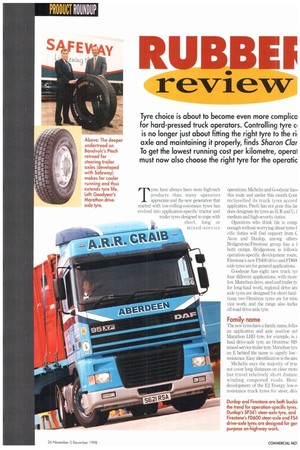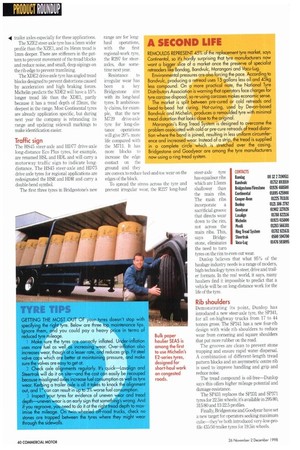RUB.BIE1
Page 41

Page 42

If you've noticed an error in this article please click here to report it so we can fix it.
review
Tyre choice is about to become even more complica for hard-pressed truck operators. Controlling tyre cl is no longer just about fitting the right tyre to the ri axle and maintaining it properly, finds Sharon Oar To get the lowest running cost per kilometre, operai must now also choose the right tyre for the operatic
Tyres have always been more high-tech products than many operators appreciate and the new generation that started with low-rolling-resistance tyres has evolved into application-specific tractor and trailer tyres designed to cope with
short, long or mixed-service
operations Michelin and Goodyear have this route and earlier this month Cont reclassified its truck tyres accord application. Pirelli has not gone this far does designate its tyres as II, Rand 12, f medium and high severity duties.
Operators who think life is comp enough without worrying about tyres f cific duties will find support from C Avon and Dunlop, among others Bridgestone/Firestone group has a f both camps. Bridgestone is followir operation-specific development route, Firestone's new FSCO drive and FD60(. axle tyres are for general applications.
Goodyear has eight new truck tyr four different applications, with more low. Marathon drive, steel and trailer ty for long-haul work; regional drive am axle tyres are designed for short-haul tions; two Ornnitrac tyres are for mix, vice work: and the range also inclm off-road drive-axle tyre.
Family name
The new tyres have a family name, folio an application and axle position suf Marathon LHD tyre, for example, is r haul drive-axle tyre; an Omnitrac MS mixed-service trailer tyre. Marathon tyre an E behind the name to signify low resistance. Easy identification is the aim Michelin says the majority of trm not cover long distances on clear mobo but travel relatively short distanc winding congested roads. Henc development of the E2 Energy low-n resistance truck tyres for steer, driv
1 trailer axles especially for these applications. The XZE2 steer-axle tyre has a 5mm wider profile than the XZF:1, and its 16mm tread is lmm deeper. There are stiffeners in the pattern to prevent movement of the tread blocks and reduce noise, and small, deep sipings on the rib edge to prevent tramlining.
The XDE2 drive-axle tyre has angled tread blocks designed to prevent distortions caused by acceleration and high braking forces. Michelin predicts the XDE2 will have a 15% longer tread life than the XDE1, partly because it has a tread depth of 23mm, the deepest in the range. Most Continental tyres are already application specific, but during next year the company is rebranding its range and updating sidewall markings to make identification easier.
Traffic sign
The HS45 steer-axle and 1-11)77 drive-axle long-distance Eco Plus tyres, for example, are renamed HSL and HDL and will carry a motorway traffic sign to indicate longdistance. The HS45 steer-axle and HD75 drive axle tyres for regional applications are redesignated the HSR and HDR and carry a double-bend symbol.
The first three tyres in Bridgestone's new range are for long haul operations, with the first regional-work tyre. the R297 for steeraxles, due sometime next year.
Resistance a . irregular wear has been a key Bridgestone aim with its long-haul tyres. It ambitiously claims, for example, that the new M729 drive-axle tyre for long-distance operations will give 20% more life compared with the M711. It has more blocks t increase the edge. contact on the ground and they are convex to reduce heel-and-toe wear on the edges of the block.
To spread the stress across the tyre and prevent irregular wear, the R227 long-haul
steer-axle tyre has equaliser ribs which are 1.5mm shallower than the main ribs. The main ribs incorporate a sacrificial groove that directs wear down to the rim, not across the main ribs. This, says Bridgestone, eliminates the need to turn tyres on the rim to even outwear.
Steertrak Vaculug Dunlop believes that what 95% of the haulage industry needs is a range of modern, high-technology tyres in steer, drive and trailer formats. In the real world, it says, many hauliers find it impossible to predict that a vehicle will be on long-distance work for the life of the tyre.
Rib shoulders
Demonstrating its point, Dunlop has introduced a new steer-axle tyre, the SP341, for all on-highway trucks from 17 to 44 tonnes gross. The SP341 has a new four-rib design with wide rib shoulders to reduce wear from cornering and square shoulders that put more rubber on the road.
The grooves are clean to prevent stone trapping and ensure rapid water dispersal. A combination of different-length tread pattern blocks and an asymmetric centre rib is used to improve handling and grip and reduce noise,
The tread compound is oil-free—Dunlop says this offers higher mileage potential and damage-resistance
The SP431 replaces the SP331 and SP371 tyres for 22.5in wheels; it's available in 295/80, 315/80 and 12-22.5 profiles.
Finally, Bridgestone and Goodyear have set a new target for operators seeking maximum cube—they've both introduced very-low-profile 435/50 trailer tyres for 19.5in wheels.
TYRE TIPS
GETTING THE MOST OUT OF your tyres doesn't stop with specifying the right tyre. Below are three top maintenance tips. Ignore them, and you could pay a heavy price in terms of _. reduced tyre mileage.
Make sure the tyres are correctly inflated. Under-inflation uses more fuel as well as increasing wear. Over-inflation also increases wear, though at a lesser rate, and reduces grip. Fit steel valve caps which are better at maintaining pressure, and make sure the valves are easy to get at.
Check axle alignments regularly. It's quick—Lasalign and Steertrak will do it on site—and the cost can easily be recouped because misaligned axles increase fuel consumption as well as tyre_ wear. Kerbing a trailer axle is all it takes to knock the alignment! out, and 1° can can result in up to 3% worse fuel consumption.
Inspect your tyres for evidence of uneven wear and tread depth—uneven wear is an early sign that something's wrong. And if you regroove, you need to do it at the right tread depth to maximise the mileage. On twin-wheeled off-road trucks, check no stones ore trapped between the tyres where they might wear through the sidewalls.
A SECOND LIFE
REMOULDS REPRESENT 45% of the replacement tyre market, says Continental, so it's hardly surprising that tyre manufacturers now want a bigger slice of a market once the preserve of specialist retreaders like Banclag, Bandvulc, Marangoni and Vacu-Lug. Environmental pressures are also forcing the pace. According to Bandvulc, producing a retread uses 15 gallons less oil and 45kg less compound. On a more practical note, the National Tyre Distributors Association is warning that operators face charges for tyre carcase disposal, so re-using carcases makes economic sense. The market is split between pre-cured or cold retreads and bead-to-bead hot curing. Hot-curing, used by Devon-based Bandvulc and Michelin, produces a remoulded tyre with minimal tread distortion that looks close to the original. Marangoni's Ring Tread System is designed to overcome the problem associated with cold or pre-cure retreads of tread distortion where the band is joined, resulting in less uniform circumference and increased wear. Instead of a strip, the tread is supplied in a complete circle which is stretched over the casing. Bridgestone and Goodyear are among the tyre manufacturers now using a ring tread system.




















































































































